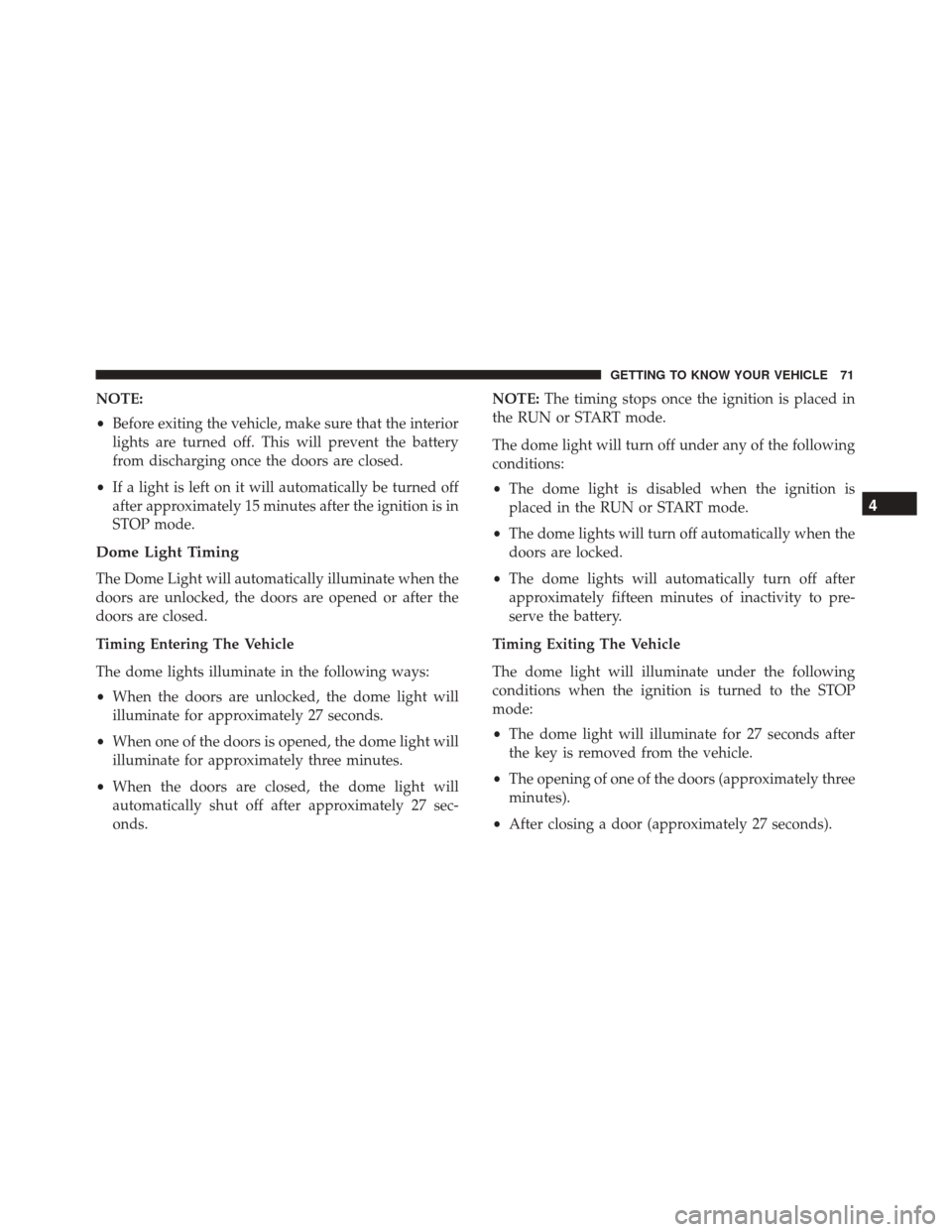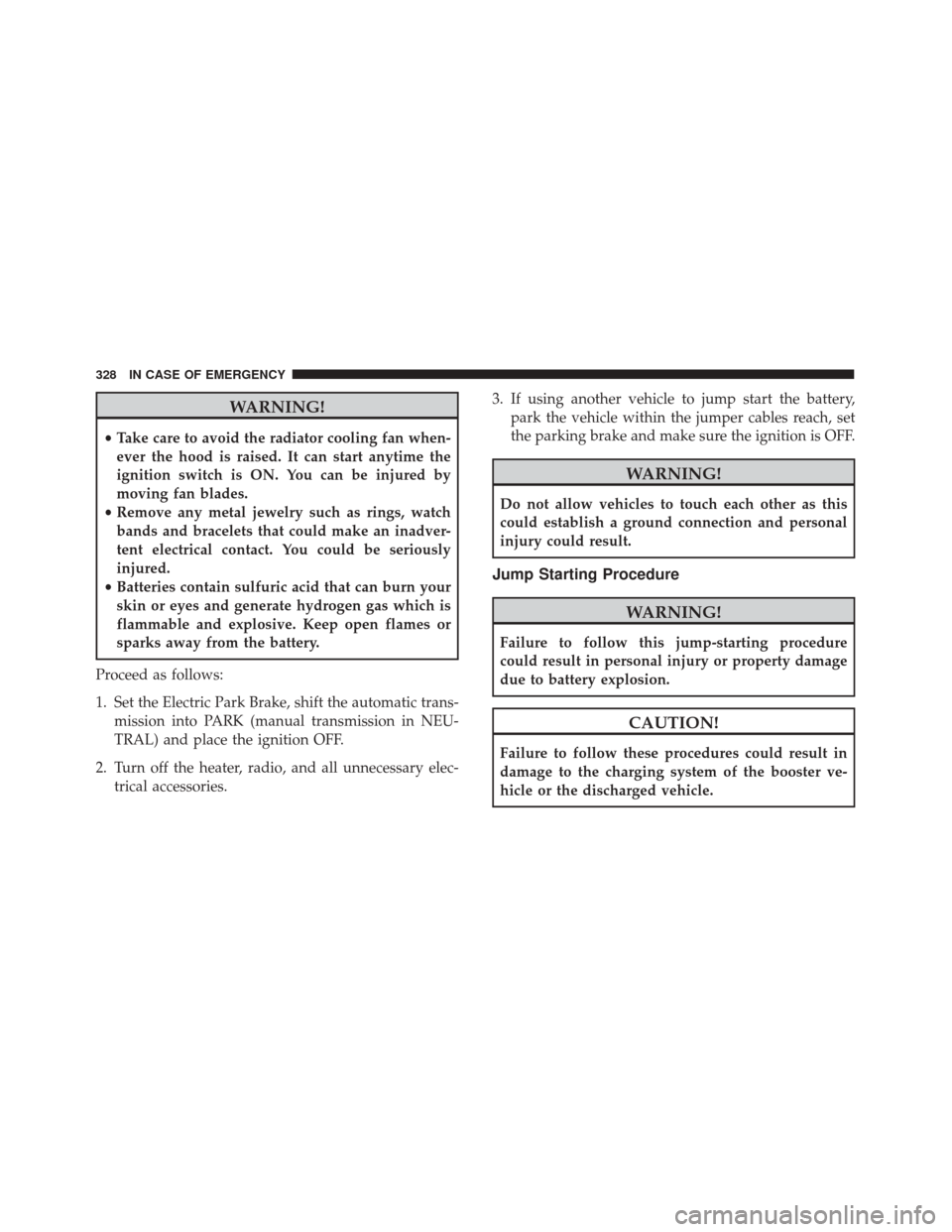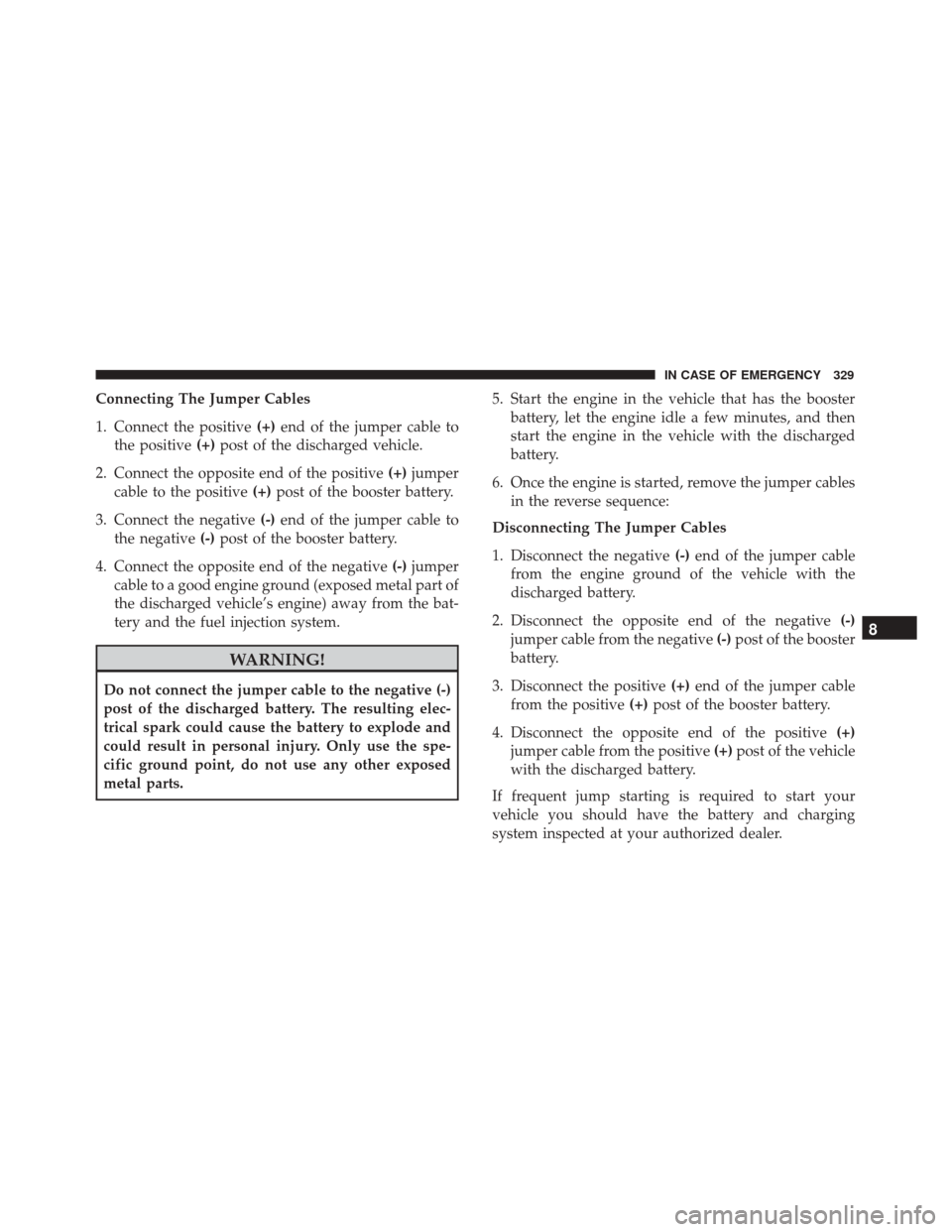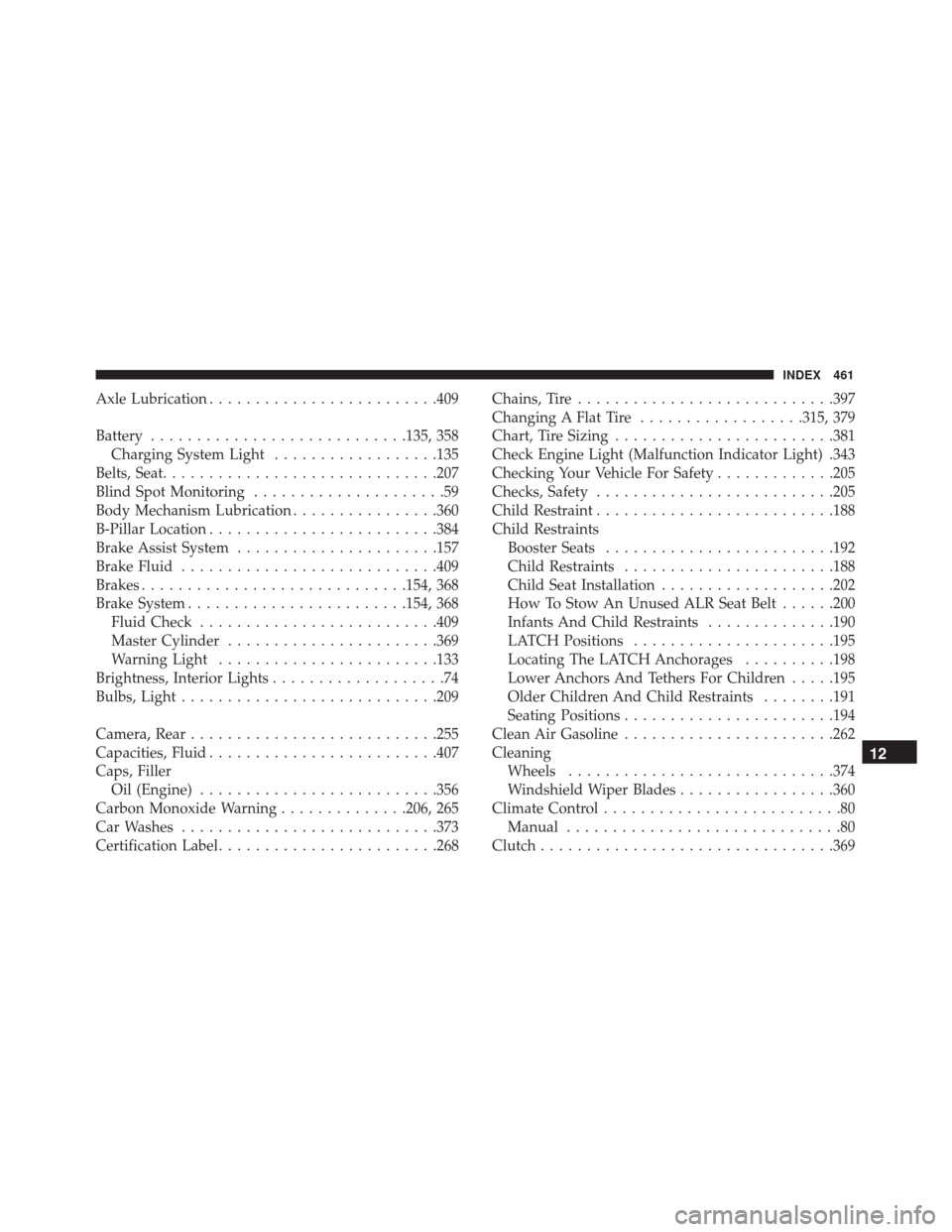2014 FIAT 500X charging
[x] Cancel search: chargingPage 73 of 476

NOTE:
•Before exiting the vehicle, make sure that the interior
lights are turned off. This will prevent the battery
from discharging once the doors are closed.
• If a light is left on it will automatically be turned off
after approximately 15 minutes after the ignition is in
STOP mode.
Dome Light Timing
The Dome Light will automatically illuminate when the
doors are unlocked, the doors are opened or after the
doors are closed.
Timing Entering The Vehicle
The dome lights illuminate in the following ways:
• When the doors are unlocked, the dome light will
illuminate for approximately 27 seconds.
• When one of the doors is opened, the dome light will
illuminate for approximately three minutes.
• When the doors are closed, the dome light will
automatically shut off after approximately 27 sec-
onds. NOTE:
The timing stops once the ignition is placed in
the RUN or START mode.
The dome light will turn off under any of the following
conditions:
• The dome light is disabled when the ignition is
placed in the RUN or START mode.
• The dome lights will turn off automatically when the
doors are locked.
• The dome lights will automatically turn off after
approximately fifteen minutes of inactivity to pre-
serve the battery.
Timing Exiting The Vehicle
The dome light will illuminate under the following
conditions when the ignition is turned to the STOP
mode:
• The dome light will illuminate for 27 seconds after
the key is removed from the vehicle.
• The opening of one of the doors (approximately three
minutes).
• After closing a door (approximately 27 seconds).
4
GETTING TO KNOW YOUR VEHICLE 71
Page 137 of 476

Operation of the Brake Warning Light can be checked
by placing the ignition in the MAR (ACC/ON/RUN)
position. The light should illuminate for approximately
two seconds. The light should then turn off unless the
parking brake is applied or a brake fault is detected. If
the light does not illuminate, have the light inspected by
an authorized dealer.The light also will turn on when the parking brake is
applied with the ignition placed in the MAR (ACC/
ON/RUN) position.
NOTE:
This light shows only that the parking brake is
applied. It does not show the degree of brake applica-
tion.
Battery Charge Warning Light
Red Telltale Light What It Means
Battery Charge Warning Light
This light illuminates when the battery is not charging properly. If it stays on while the en-
gine is running, there may be a malfunction with the charging system. Contact your autho-
rized dealer as soon as possible. This indicates a possible problem with the electrical system
or a related component.
If jump starting is required, refer to “Jump Starting” in “In Case Of Emergency.”
5
GETTING TO KNOW YOUR INSTRUMENT PANEL 135
Page 330 of 476

WARNING!
•Take care to avoid the radiator cooling fan when-
ever the hood is raised. It can start anytime the
ignition switch is ON. You can be injured by
moving fan blades.
• Remove any metal jewelry such as rings, watch
bands and bracelets that could make an inadver-
tent electrical contact. You could be seriously
injured.
• Batteries contain sulfuric acid that can burn your
skin or eyes and generate hydrogen gas which is
flammable and explosive. Keep open flames or
sparks away from the battery.
Proceed as follows:
1. Set the Electric Park Brake, shift the automatic trans- mission into PARK (manual transmission in NEU-
TRAL) and place the ignition OFF.
2. Turn off the heater, radio, and all unnecessary elec- trical accessories. 3. If using another vehicle to jump start the battery,
park the vehicle within the jumper cables reach, set
the parking brake and make sure the ignition is OFF.
WARNING!
Do not allow vehicles to touch each other as this
could establish a ground connection and personal
injury could result.
Jump Starting Procedure
WARNING!
Failure to follow this jump-starting procedure
could result in personal injury or property damage
due to battery explosion.
CAUTION!
Failure to follow these procedures could result in
damage to the charging system of the booster ve-
hicle or the discharged vehicle.
328 IN CASE OF EMERGENCY
Page 331 of 476

Connecting The Jumper Cables
1. Connect the positive(+)end of the jumper cable to
the positive (+)post of the discharged vehicle.
2. Connect the opposite end of the positive (+)jumper
cable to the positive (+)post of the booster battery.
3. Connect the negative (-)end of the jumper cable to
the negative (-)post of the booster battery.
4. Connect the opposite end of the negative (-)jumper
cable to a good engine ground (exposed metal part of
the discharged vehicle’s engine) away from the bat-
tery and the fuel injection system.
WARNING!
Do not connect the jumper cable to the negative (-)
post of the discharged battery. The resulting elec-
trical spark could cause the battery to explode and
could result in personal injury. Only use the spe-
cific ground point, do not use any other exposed
metal parts. 5. Start the engine in the vehicle that has the booster
battery, let the engine idle a few minutes, and then
start the engine in the vehicle with the discharged
battery.
6. Once the engine is started, remove the jumper cables in the reverse sequence:
Disconnecting The Jumper Cables
1. Disconnect the negative (-)end of the jumper cable
from the engine ground of the vehicle with the
discharged battery.
2. Disconnect the opposite end of the negative (-)
jumper cable from the negative (-)post of the booster
battery.
3. Disconnect the positive (+)end of the jumper cable
from the positive (+)post of the booster battery.
4. Disconnect the opposite end of the positive (+)
jumper cable from the positive (+)post of the vehicle
with the discharged battery.
If frequent jump starting is required to start your
vehicle you should have the battery and charging
system inspected at your authorized dealer.
8
IN CASE OF EMERGENCY 329
Page 463 of 476

Axle Lubrication........................ .409
Battery ........................... .135, 358
Charging System Light ..................135
Belts, Seat ............................. .207
Blind Spot Monitoring .....................59
Body Mechanism Lubrication ................360
B-Pillar Location ........................ .384
Brake Assist System ..................... .157
Brake Fluid ........................... .409
Brakes ............................ .154, 368
Brake System ....................... .154, 368
Fluid Check ......................... .409
Master Cylinder ...................... .369
Warning Light ....................... .133
Brightness, Interior Lights ...................74
Bulbs, Light ........................... .209
Camera, Rear .......................... .255
Capacities, Fluid ........................ .407
Caps, Filler Oil (Engine) ......................... .356
Carbon Monoxide Warning ..............206, 265
Car Washes ........................... .373
Certification Label ....................... .268Chains, Tire
........................... .397
Changing A Flat Tire ..................315, 379
Chart, Tire Sizing ....................... .381
Check Engine Light (Malfunction Indicator Light) .343
Checking Your Vehicle For Safety .............205
Checks, Safety ......................... .205
Child Restraint ......................... .188
Child Restraints Booster Seats ........................ .192
Child Restraints ...................... .188
Child Seat Installation ...................202
How To Stow An Unused ALR Seat Belt ......200
Infants And Child Restraints ..............190
LATCH Positions ..................... .195
Locating
The LATCH Anchorages ..........198
Lower Anchors And Tethers For Children .....195
Older Children And Child Restraints ........191
Seating Positions ...................... .194
Clean Air Gasoline ...................... .262
Cleaning Wheels ............................ .374
Windshield Wiper Blades .................360
Climate Control ..........................80
Manual ..............................80
Clutch ............................... .369
12
INDEX 461